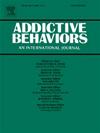抽样调查的美国年轻成年人对衍生精神活性大麻产品的看法和使用情况
IF 3.7
2区 医学
Q1 PSYCHOLOGY, CLINICAL
引用次数: 0
摘要
方法 我们分析了 2023 年对 4,031 名年轻成年人(18-34 岁)的调查数据,其中 50% 以上报告过去一个月使用过大麻。多变量回归分析了社会人口统计学、大麻使用情况和 DPCP 风险认知与以下方面的关系:1)过去一个月 DPCP 的使用情况;2)过去一个月 DPCP 的使用情况;3)过去一个月 DPCP 的使用情况;4)过去一个月 DPCP 的使用情况:1) 过去一个月使用 DPCP 的情况(是/否),2) 过去一个月使用 DPCP 的天数,以及 3) 在报告过去一个月未使用 DPCP 的人群中,未来使用 DPCP 的可能性。9%为白人,19.4%为西班牙裔)中,DPCP知晓率(67.5%)、终生使用率(41.7%)和上月使用率(24.4%)因上月吸食大麻与未吸食大麻而异(分别为 87.0% vs 48.8%、68.7% vs 15.9%、45.6% vs 4.2%)。了解这些药物的人主要是从朋友/家人那里得知的(44.5%),他们认为DPCPs必须经过测试和批准才是安全的(70.3%),或者是由美国食品和药物管理局批准的(59.0%)。曾经使用过DPCPs的人最常使用δ-8(69.7%)和δ-9(44.4%)四氢大麻酚,出于好奇(55.5%)、相信联邦合法性(34.1%)和朋友建议(34.0%)。与上月使用非医用大麻、使用频率更高以及未来使用可能性更大相关的因素是:非医用大麻危害感知较低和成瘾感知较高。生活在非医用大麻非法的地方、社会接受度较高、黑人(相对于白人)和上月使用大麻也与上月使用情况(但不包括使用频率)和未来使用可能性相关。与此相关的是,DPCP 监管,包括营销和分销,至关重要。本文章由计算机程序翻译,如有差异,请以英文原文为准。
Derived psychoactive cannabis product perceptions and use among a sample of US young adults
Aims
To characterize derived psychoactive cannabis product (DPCP) perceptions and use among US young adults.
Methods
We analyzed 2023 survey data among 4,031 young adults (ages 18–34), comprising ∼ 50 % reporting past-month cannabis use. Multivariable regressions examined sociodemographics, cannabis use, and DPCP risk perceptions in relation to: 1) past-month DPCP use (yes/no), 2) past-month number of DPCP use days, and 3) among those reporting no past-month DPCP use, future likelihood of DPCP use.
Results
In this sample (Mage = 26.3, 59.8 % female, 64.9 % White, 19.4 % Hispanic), DPCP awareness (67.5 %), lifetime use (41.7 %), and past-month use (24.4 %) differed by past-month cannabis use versus nonuse (87.0 % vs 48.8 %, 68.7 % vs 15.9 %, 45.6 % vs 4.2 %, respectively). Those aware learned about them mainly from friends/family (44.5 %) and believed DPCPs were required to be tested and approved to be safe (70.3 %) or were approved by the US Food and Drug Administration (59.0 %). Those who ever used DPCPs most often used delta-8 (69.7 %) and delta-9 (44.4 %) THC and for curiosity (55.5 %), belief of federal legality (34.1 %), and friends’ suggestion (34.0 %). Correlates of past-month DPCP use, using more frequently, and higher likelihood of future use were: lower DPCP perceived harm and higher perceived addictiveness. Living where non-medical cannabis was illegal, higher perceived social acceptability, being Black (vs. White), and past-month cannabis use were also correlated with past-month use (but not frequency) and future likelihood of use.
Conclusions
Efforts are needed to better understand DPCPs’ risks and correct consumer misperceptions. Relatedly, DPCP regulation, including marketing and distribution, is crucial.
求助全文
通过发布文献求助,成功后即可免费获取论文全文。
去求助
来源期刊

Addictive behaviors
医学-药物滥用
CiteScore
8.40
自引率
4.50%
发文量
283
审稿时长
46 days
期刊介绍:
Addictive Behaviors is an international peer-reviewed journal publishing high quality human research on addictive behaviors and disorders since 1975. The journal accepts submissions of full-length papers and short communications on substance-related addictions such as the abuse of alcohol, drugs and nicotine, and behavioral addictions involving gambling and technology. We primarily publish behavioral and psychosocial research but our articles span the fields of psychology, sociology, psychiatry, epidemiology, social policy, medicine, pharmacology and neuroscience. While theoretical orientations are diverse, the emphasis of the journal is primarily empirical. That is, sound experimental design combined with valid, reliable assessment and evaluation procedures are a requisite for acceptance. However, innovative and empirically oriented case studies that might encourage new lines of inquiry are accepted as well. Studies that clearly contribute to current knowledge of etiology, prevention, social policy or treatment are given priority. Scholarly commentaries on topical issues, systematic reviews, and mini reviews are encouraged. We especially welcome multimedia papers that incorporate video or audio components to better display methodology or findings.
Studies can also be submitted to Addictive Behaviors? companion title, the open access journal Addictive Behaviors Reports, which has a particular interest in ''non-traditional'', innovative and empirically-oriented research such as negative/null data papers, replication studies, case reports on novel treatments, and cross-cultural research.
 求助内容:
求助内容: 应助结果提醒方式:
应助结果提醒方式:


